This is a book I picked at the library without seeing anything more than the title on the spine. I was in a hurry because both children are now walking, and neither wants to sit still. The title sounded good, the cover looked good, and there aren't so many words per page that my kids will get bored. We love this book.
We've ordered not just a copy for ourselves but two more to give as gifts. It's a cute story, I would like my children to learn or think about the lesson, and there are several parts that flat out make my children laugh.
There are a few lessons in this story. The first (and blindingly obvious) is that one doesn't need money to be happy in life. There's a message about believing everything you read, and when the princess is mixed up with a piglet the characters attempt to explain what happened referencing fairy tales of old. There is another message about the ridiculous things we will believe because they validate our status in society or our world view, but this is a children's book and I may be reading into it too much. Maybe not.
Watching Baby
Friday, June 5, 2015
Tuesday, December 23, 2014
Skip Hop Pronto! Changing Station
Here is one product that has been invaluable to us, the Skip Hop Pronto! changing station. It turns anywhere into a place to change your child's diaper, and is pretty convenient. It has several pockets for wipes and diapers, and clips so it can be attached to many things.
The website lets you look at all of the available designs and you can zoom in to see the different patterns. We have the design you see here to the right, "black." They're named after the outside color/design.
It has several pockets, and we use the inside zip pocket for wipes and the mesh pocket (with velcro to open and close) for diapers. The website says you can use the outer pocket for wallets and keys and things, but this is where our older child's head rests during the diaper change, and my keys do just fine in my pocket.
As I said earlier you can change your child's diaper anywhere you need to with this product, as evidenced by all the different places I've done it myself. We tend to use it even when there is a diaper station in a public bathroom because who knows what happens on those things in some of these bathrooms. It turns the trunk of my car into a changing station, the floor of an empty classroom Now that we have two children, sometimes one is napping in the bedroom with the changing table so I'll use it right in the living room.
The steps are easy. Unclip it to open and fold out all the way. Unzip the pocket and take out the wipes and a fresh diaper. I aim my child's bum right at the center of the part that unfolds so there is as much material all around him/her. My son is big enough now that the mat doesn't overlap completely anymore, and there was a period of time when his head lined up with a scratchy piece of velcro on part of it, but laying him down at a slight angle solved the problem. The mat folds easily again, and that piece of velcro keeps the changing area folded while you clip it closed completely. If you want to clip it to your belt or to a backpack or stroller or whatever there's a separate loop and clip, and the whole thing has enough of what you need
Really the mat serves two purposes depending on where you are. If you're on the floor of a Dunkin' Donuts bathroom it protects your child from the outside germs, but in the trunk of your car it protects the trunk from the germs in the diaper. I can think of one time in particular when my there was a messy diaper that had leaked out onto clothes and my trunk was full; I had to change the diaper in the back seat of my car and the Pronto! mat kept it clean through the whole ordeal.
Really the mat serves two purposes depending on where you are. If you're on the floor of a Dunkin' Donuts bathroom it protects your child from the outside germs, but in the trunk of your car it protects the trunk from the germs in the diaper. I can think of one time in particular when my there was a messy diaper that had leaked out onto clothes and my trunk was full; I had to change the diaper in the back seat of my car and the Pronto! mat kept it clean through the whole ordeal.
The bottom line: we love this product.
And a reminder, this is not a paid endorsement of this product. I don't get anything from Skip * Hop for writing this, this is just my opinion on one of their products. I haven't tried any other portable changing stations to compare this to because I haven't needed any others. After almost three years of heavy use it shows no real signs of wear.
Tuesday, December 9, 2014
Hand, Hand, Fingers, Thumb by Al Perkins
 Today I'm reviewing a book we own called Hand, Hand, Fingers, Thumb, by Al Perkins and illustrated by Eric Gurney. It is a 22-page board book first published in 1969, and it's one of these books like those by P. D. Eastman that are somehow affiliated with Dr. Seuss. We've had the book since before my son was born, so I've been getting to know it for close to three years. It's showing signs of its age; the edges are frayed, the spine is half gone, and the book kind of wobbles as you read it. There's a reason we read this book so much, and it's one of the many things we learned at a place called Isis Parenting.
Today I'm reviewing a book we own called Hand, Hand, Fingers, Thumb, by Al Perkins and illustrated by Eric Gurney. It is a 22-page board book first published in 1969, and it's one of these books like those by P. D. Eastman that are somehow affiliated with Dr. Seuss. We've had the book since before my son was born, so I've been getting to know it for close to three years. It's showing signs of its age; the edges are frayed, the spine is half gone, and the book kind of wobbles as you read it. There's a reason we read this book so much, and it's one of the many things we learned at a place called Isis Parenting. We took several classes at the now defunct Isis Parenting (you can read all about its closing in Fortune Magazine) and in one class they recommended we each choose one book to read every night as part of the bedtime routine. The more consistent the bedtime routine the better, and this was the book I chose to read every night as part of the routine. There were some days when I read it to my son three times a day: before morning nap, before afternoon nap, and before going to bed for the night.
The book is relatively simple and tells a story of musical monkeys assembling to play (mostly) the drums. Some monkeys turn up who play banjos and fiddles, but in the end it's millions of monkeys with millions of drums as far as the eye can see. There is a rhythm to the prose, and when I found it sometimes the hardest part was turning the pages fast enough to keep the beat. Soon I had the book memorized and it was an easy go-to book. This is a good trick if you are away from home on business and need to read books to your child over the phone. You can buy two copies of a book and bring one with you while your child reads the other at home, but if you forget your copy or something happens to it you can instead recite a book like this.
I think it's interesting to note that a lot of these old stories that have been turned into board books have also been shortened from the original book. In searching for it on google I saw some images of pages that aren't in the board book, and I would be interested to get a copy of the full book and see if the rhythm is the same.
I also found several different readings and/or animations on youtube, and liked this one the best. This is the board book version, so some of the pages from the original are not there. It's interesting to hear someone else read the book and compare it to my own inflection when I read it. The rhythm in the video is the same but this guy has actual drum accompaniment.
The bottom line: this book is like a member of our family.
Friday, December 5, 2014
Urban Babies Wear Black by Michelle Sinclair Colman
 This week we got Urban Babies Wear Black by Michelle Sinclair Colman and illustrated by Nathalie Dion from the library. I can't decide if it is a tongue-in-cheek look at babies doing things that are stereotyped as urban (in a yuppie kind of way) or meant to be true. The book is 18 pages long and has words on the left with a picture on the right. It begins with the titular urban babies wear black and has the babies doing yoga, visiting art galleries, jogging (in a stroller), drinking latte, enjoying architecture, appreciating fine dining, going to the opera, and taking a taxi at the end of the day.
This week we got Urban Babies Wear Black by Michelle Sinclair Colman and illustrated by Nathalie Dion from the library. I can't decide if it is a tongue-in-cheek look at babies doing things that are stereotyped as urban (in a yuppie kind of way) or meant to be true. The book is 18 pages long and has words on the left with a picture on the right. It begins with the titular urban babies wear black and has the babies doing yoga, visiting art galleries, jogging (in a stroller), drinking latte, enjoying architecture, appreciating fine dining, going to the opera, and taking a taxi at the end of the day.
I think the art is cool and very expressive, but I'm not completely happy with some of the messages. There are many reasons children shouldn't drink coffee, and the page pictured below contradicts us when we tell our son he's too young for coffee.
 |
| Babies shouldn't drink lattes. |
I do really enjoy the art in this book, it has a cool and distinct style. I read that the artist, Nathalie Dion, is from Montreal, and would be interested to know if she had any particular city in mind when she created the illustrations.
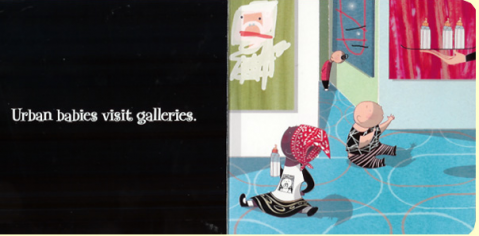 |
| The art is very cool |
I do think the book is cute and somewhat humorous, but we read these books for our kids so I have to go with how they react to it. My 10-month old isn't really that into it, nor has it captured the interest of my 2 1/2 year old. It's a quick read and I'm not upset by its playful jest about urban babies, but I wouldn't need to purchase this book for myself (or take it out of the library again). There are more in the series about beach babies, country babies, foodie babies, and more. Any of them would probably make good gifts to make fun of people who want their kids to identify with those labels.
The bottom line: this book is okay.
Thursday, December 4, 2014
We Love Each Other by Yusuke Yonezu
 This week we took out this board book at the library by Yusuke Yonezu: We Love Each Other. Board books are great because they can withstand the rough handling of young children, and my 10-month old insists on holding her own book during story time. My 2 1/2 year old is capable of turning the pages of a regular picture book, but he still creases them and tears them occasionally so I still lean towards reading board books with them.
This week we took out this board book at the library by Yusuke Yonezu: We Love Each Other. Board books are great because they can withstand the rough handling of young children, and my 10-month old insists on holding her own book during story time. My 2 1/2 year old is capable of turning the pages of a regular picture book, but he still creases them and tears them occasionally so I still lean towards reading board books with them.
We Love Each Other is an adorable and simple book with cut out pages that turn two animals, who (as the title would suggest) love each other, into a geometric shape. Shapes include a heart, triangle, circle, semi-circle, trapezoid, square, and rectangle. The pictures are cute and the expressions of the animals change so they are smiling when they are together on their final page. The book is 28 pages long but only has words every fourth page, so it can be a quick read.
In searching for images of the book I found another site that named this their book of the week on February 12, 2014. The images below demonstrating how the cut out pages work come from the make light home made photography blog:
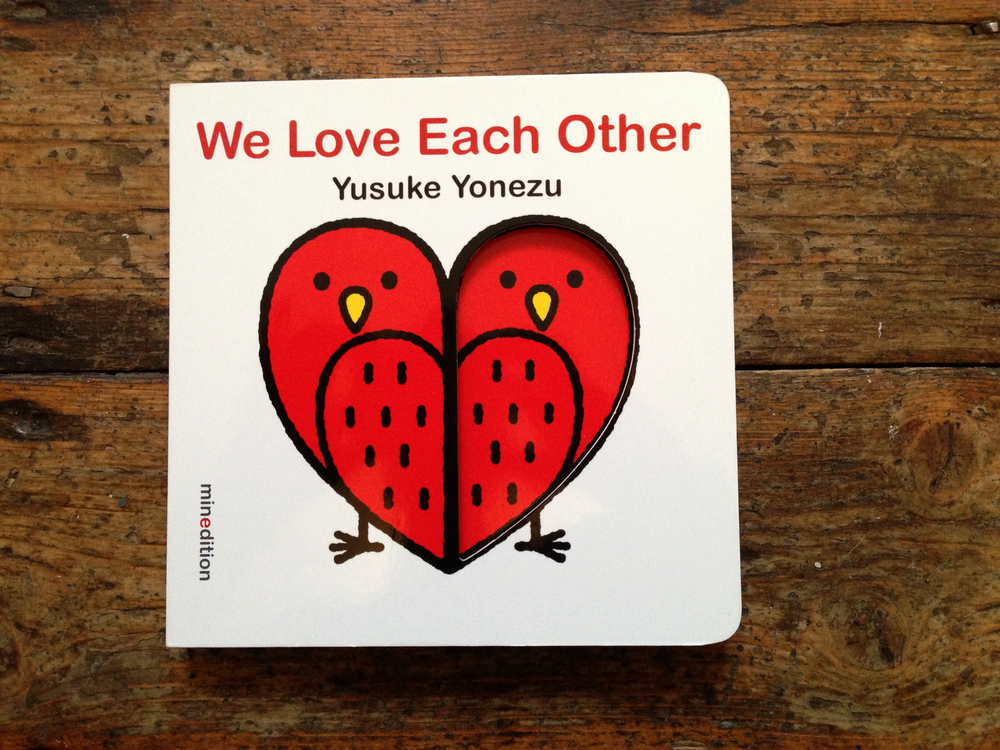 |
| The cover (the right side of the birds is cut out) |
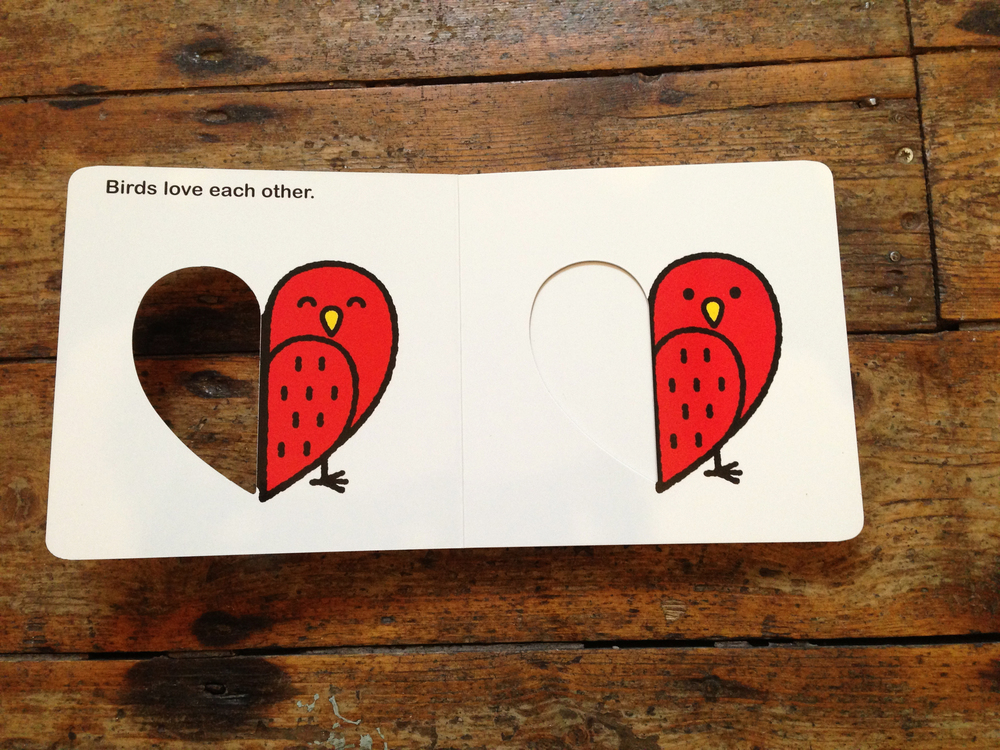 |
| On the first page the birds are apart |
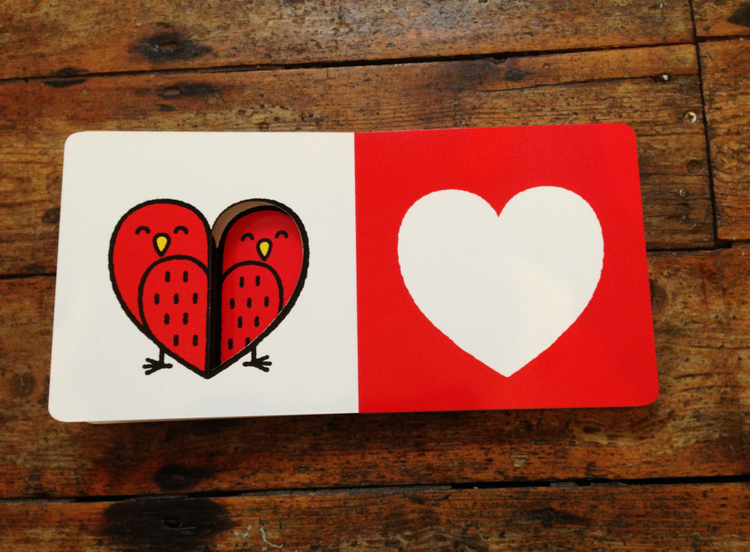 |
| Then brought together again revealing a heart |
The blog suggests this book for Valentine's Day, which is a fantastic idea. Here are some more images from the book demonstrating the artwork and how the animals become shapes:
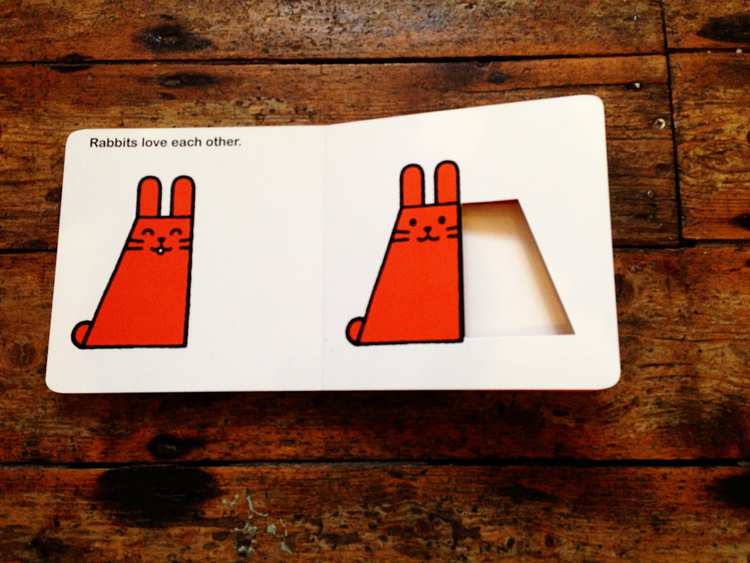 |
| The rabbits form a trapezoid |
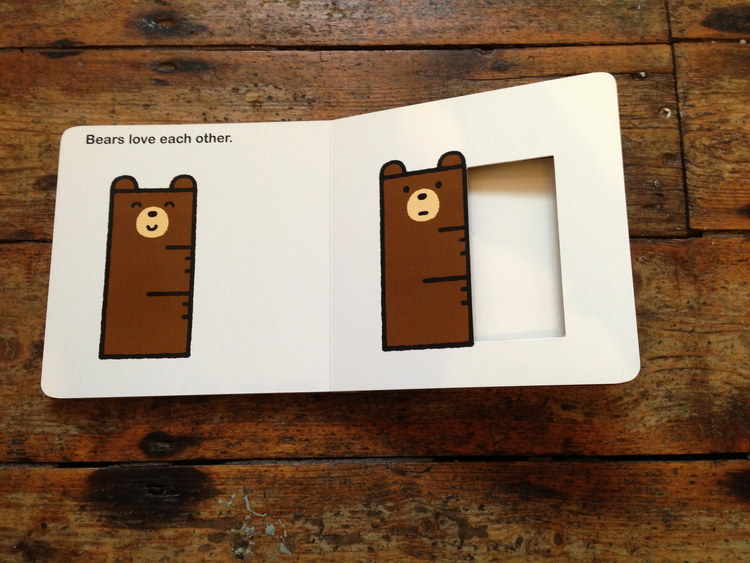 |
| Two rectangular bears... |
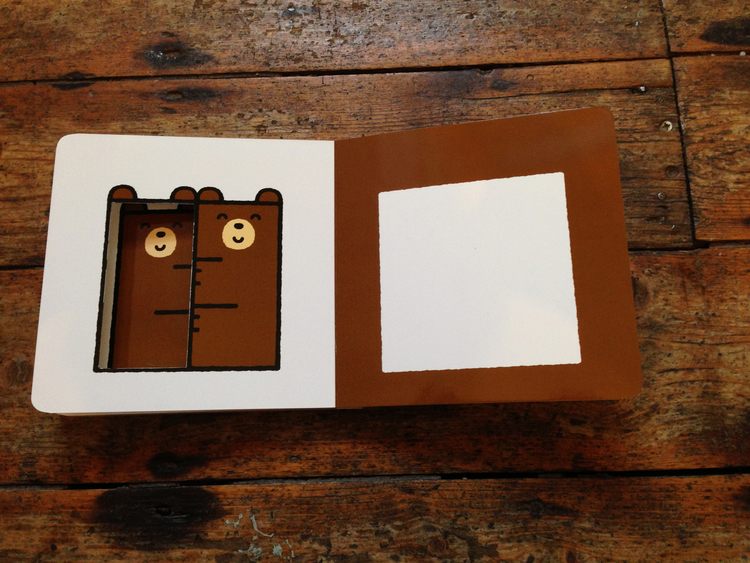 |
| ...make a square |
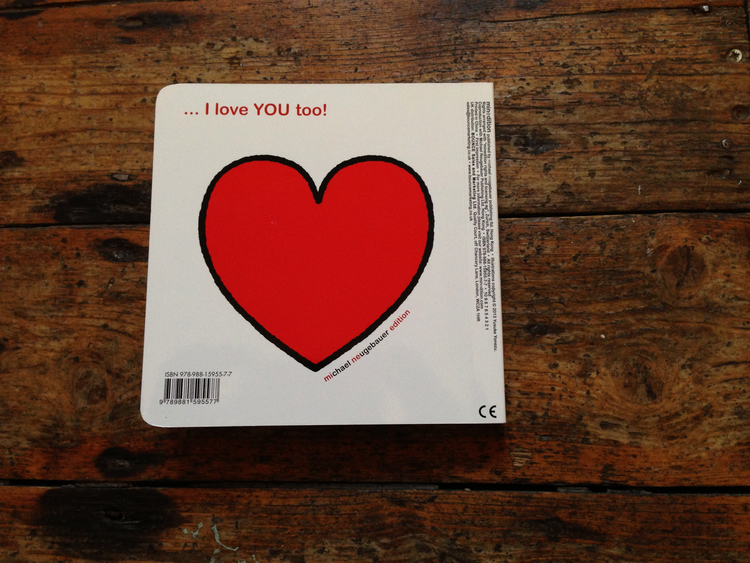 |
| The back cover |
I also found this article from the New York Times with a paragraph (the second in the article) devoted to the book. The article, Love for the Littlest by Sarah Harrison Smith, was published on February 5, 2014 and puts my review to shame in its eloquence and ability to stay on topic. Seriously, read this:
In “We Love Each Other,” a board book, the Japanese artist Yusuke Yonezu (“A Cup for Everyone”) uses clever cutouts to convey — without ever stating outright — the message that loves completes us. As readers flip the glossy cardboard pages, animals first shown next to empty spaces meet their mirror images, and the happy couple together form a new shape. Two little red birds snuggle side by side to create a heart; blue mice, with their noses in the air, lean in to construct a triangle; a big elephant and a little one combine to make a semicircle; and so on. At last, a group of cats break the pattern because, as parents well know, sometimes one plus one equals three. Yonezu incorporates simple sentences that may be within reach of some early readers, but his ingenious pictures are the main attraction.
Smith's review reveals a shortcoming of the book for single parent families, as this final image of the cats might be exclusionary.
My children really like this book, and love the pictures. It's a quick read and has cute and familiar animals. This is a great book for Valentine's Day.
The bottom line: we like this book.
Friday, November 21, 2014
Gerber Baby Photo Contest 2014
So the Gerber Baby Photo Contest is on again, and this time you don't have to vote through facebook or some other social media site but directly on the gerber website. Follow this link (https://gerber.promo.eprize.com/photosearch2014/) to vote or register your child for the contest.
My whole write up about the thing somehow got deleted by blogger, and it's really hard to rewrite something you already finished and published but then somehow disappeared.
You can find the winners of the contest by following this link (http://bit.ly/1qGTtWS) after January 30, 2015. So that means you have to wait. People always want to know how many votes their child has, but all you can do is wait until the winners are announced at the end of January. Our child participated in the contest in 2012, and if you want to read all about it then check out my 2012 post.
My whole write up about the thing somehow got deleted by blogger, and it's really hard to rewrite something you already finished and published but then somehow disappeared.
You can find the winners of the contest by following this link (http://bit.ly/1qGTtWS) after January 30, 2015. So that means you have to wait. People always want to know how many votes their child has, but all you can do is wait until the winners are announced at the end of January. Our child participated in the contest in 2012, and if you want to read all about it then check out my 2012 post.
Mommy! Mommy! by Taro Gomi
It's been such a long time since I've written about my child that now I have to say children because we've had a second child. Over the months we've started going to the local library's story hour every week, and read quite a few new children's books. I thought it might be a good way for me to ease back into writing here if I shared some of my favorite books - books that we take out over and over again or have purchased because we liked them so much. I'll review one book per post to keep things manageable, and try to talk about a variety of topics. Maybe I'll develop some categories to use in considering each book, but now things are getting complicated and I want to let this evolve on its own.
The first book I have chosen is Mommy! Mommy! by Taro Gomi, a book we borrowed from the library. It's a board book, and 11 pages long. Taro Gomi is the author and artist, and when you open the book the left and right sides of the page form one image. The images are simple and very cute, and the story is almost like dialog to a game of hide-and-seek between some baby chickens and their mother. The chicks mistake a flower and some kind of warthog thing for their mother and say oops, and I don't want to spoil the ending but they do eventually find their mother. The book averages a little more than two words to a page, in part because of a five-word last page. It is the simplicity of this book that makes it so good, and there are a lot of cute little details in the art that seems familiar but different in a way.
This is a book that has all of its publishing information on the back cover, and I learned a lot from it before I googled the artist and learned even more. The back cover reads:
The book also has an original copyright of 2004 being published in Japan by Crayon House Co., Ltd. It was first published in the United States in 2013 by Chronicle Books LLC., and was translated by Chronicle Books. So I thought that was cool, and it may have explained some of the art.
When I googled Gomi I instantly recognized his book Everyone Poops, which I think is well known in the United States. I didn't have it as a child, but I'm sure over the years I've seen it in the houses of friends with younger siblings. He also has a storybook The Crocodile and the Dentist that looks familiar to me, and I think when we go to the library again I will look for more books by Taro Gomi.
My 2.5 year old likes the book, and my 9-month old loves the book as well. She sits and watches the book the entire time, unlike when we're reading some wordier books and she tries to squirm away.
Both of my children love Mommy! Mommy! by Taro Gomi, and the book provides a lot of opportunity for silliness with its adorable art. It can be an introduction to Gomi's work and to Japanese art and culture. There's a simple grammar lesson there too, as the hen says at first "here I am," then later switches to "there you are."
 |
| Mommy! Mommy! by Taro Gomi |
The first book I have chosen is Mommy! Mommy! by Taro Gomi, a book we borrowed from the library. It's a board book, and 11 pages long. Taro Gomi is the author and artist, and when you open the book the left and right sides of the page form one image. The images are simple and very cute, and the story is almost like dialog to a game of hide-and-seek between some baby chickens and their mother. The chicks mistake a flower and some kind of warthog thing for their mother and say oops, and I don't want to spoil the ending but they do eventually find their mother. The book averages a little more than two words to a page, in part because of a five-word last page. It is the simplicity of this book that makes it so good, and there are a lot of cute little details in the art that seems familiar but different in a way.
This is a book that has all of its publishing information on the back cover, and I learned a lot from it before I googled the artist and learned even more. The back cover reads:
"Babies know their mommies anywhere. See, there she is right- wait, that's not Mommy! Acclaimed author and illustrator Taro Gomi creates a playful world where readers follow two chicks on a search through the barnyard for their mother hen."
The book also has an original copyright of 2004 being published in Japan by Crayon House Co., Ltd. It was first published in the United States in 2013 by Chronicle Books LLC., and was translated by Chronicle Books. So I thought that was cool, and it may have explained some of the art.
When I googled Gomi I instantly recognized his book Everyone Poops, which I think is well known in the United States. I didn't have it as a child, but I'm sure over the years I've seen it in the houses of friends with younger siblings. He also has a storybook The Crocodile and the Dentist that looks familiar to me, and I think when we go to the library again I will look for more books by Taro Gomi.
My 2.5 year old likes the book, and my 9-month old loves the book as well. She sits and watches the book the entire time, unlike when we're reading some wordier books and she tries to squirm away.
Both of my children love Mommy! Mommy! by Taro Gomi, and the book provides a lot of opportunity for silliness with its adorable art. It can be an introduction to Gomi's work and to Japanese art and culture. There's a simple grammar lesson there too, as the hen says at first "here I am," then later switches to "there you are."
The bottom line: we like this book a lot.
Subscribe to:
Comments (Atom)
Popular Posts
-
So today was one of the scariest days since taking our son to the NICU on the fourth day of his life, a story I'll have to tell another ...
-
On the news two days ago there was a story about elevated levels of arsenic in rice in the United States. At first I only marginally pa...
-
We went in for baby's 9 month checkup last week, but he had some fluid in his ears so the doctor prescribed some amoxicillin to help it ...
-
As you may know, the Bumbo baby seat was recently recalled. The safety strap can be ordered (in the United States) by calling 866-898-4999 ...
-
The winners are in! The grand prize winner is Mary Jane Montoya of Fresno California, pictured below. I don't know if she's as cu...
-
Over Labor Day weekend we were fortunate to take baby swimming in our friend's salt water pool. Our child is a pisces, and my wife and ...
-
I think my first set of Halloween ideas is still the best, but I've had a few more ideas for a baby's first Halloween. Some are m...
-
So January was a tough month for sickness in our house, as baby got the flu twice and at least one ear infection. We thought that we would ...
-
Today we took baby to the Boston Marathon. We left soon after his morning nap, and drove to where we used to live near Coolidge Corner in B...
-
Today I took my 6 1/2-month old baby boy to get a flu shot. He had four shots last week, so I'm not as worried about the actual shot, b...


